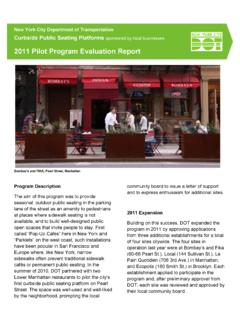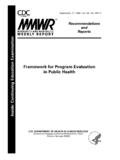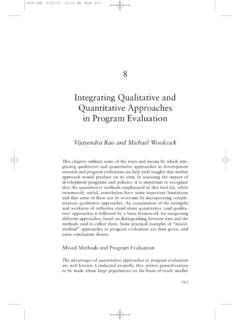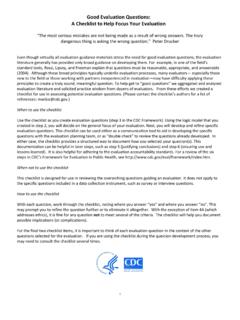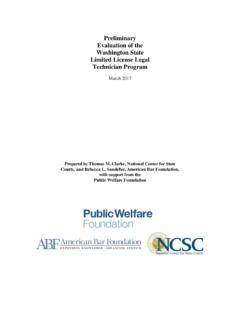Transcription of PROGRAM EVALUATION MODEL 9-STEP PROCESS
1 PROGRAM EVALUATION MODEL . 9-STEP PROCESS . by Janet E. Wall, EdD, CDFI. President, Sage Solutions What Is EVALUATION ? An EVALUATION is a purposeful, systematic, and careful collection and analysis of information used for the purpose of documenting the effectiveness and impact of programs , establishing accountability and identifying areas needing change and improvement. Summative EVALUATION There are many types of EVALUATION , depending on the purpose, timing, and procedures used. A. summative EVALUATION , sometimes called outcome EVALUATION , is conducted for the purpose of documenting the results of a PROGRAM . Specific goals of a PROGRAM are identified and the degree of accomplishment of those goals is documented. The results of a summative EVALUATION might point to changes that should be made in a PROGRAM in order to improve it in subsequent implementations.
2 The results of summative evaluations can specify PROGRAM status and conditions for accountability purposes. The results can also be used as a needs assessment for the subsequent planning of changes in a PROGRAM or of the introduction of new programs and interventions. The following table presents some questions that might be addressed by a summative EVALUATION . When Conducted Examples of Summative EVALUATION Questions After a PROGRAM has What did the PROGRAM accomplish? been implemented Did the PROGRAM reach its goals and objectives? and completed What impact did the PROGRAM have on its recipients? What were the outcomes? Who benefited from the PROGRAM ? How much was the benefit? Was the benefit greater with this PROGRAM as compared with another PROGRAM ? Did all types of students or clients benefit from the PROGRAM ?
3 What were the positive outcomes? What were the negative outcomes? What should be improved/changed in the PROGRAM ? Does the benefit of the PROGRAM warrant the cost? 1. Formative EVALUATION A formative EVALUATION , also known as PROCESS or implementation EVALUATION , is performed to examine various aspects of an ongoing PROGRAM in order to make changes/improvements as the PROGRAM is being implemented. This type of EVALUATION attempts to document exactly what is transpiring in a PROGRAM . Data are collected and analyzed at a time when PROGRAM changes can be made to ensure that the quality of the PROGRAM implementation is maintained throughout. For example, if a career development PROGRAM has been introduced in a school district, it is important to know to what extent the PROGRAM has actually been implemented as designed.
4 The following table suggests some questions that might be addressed in a formative EVALUATION . When Conducted Examples of Formative EVALUATION Questions While the PROGRAM is Is the PROGRAM being implemented as it was designed? ongoing perhaps Do the students or clients understand the PROGRAM 's concepts? several times What are the misconceptions about the PROGRAM ? Are all PROGRAM implementers implementing the PROGRAM in the same way? Is the PROGRAM being implemented on schedule? Is there sufficient time to implement all aspects of the PROGRAM ? What aspects of the PROGRAM do not seem to be working as well as you intended? Do PROGRAM implementers need additional training on the PROGRAM ? Are there any negative outcomes surfacing? Who Should Conduct or Lead the EVALUATION PROCESS ?
5 In some instances an EVALUATION is designed to answer multiple questions at multiple locations with multiple types of individuals using sophisticated statistical techniques. In such cases it is best to bring in a professionally trained individual or company to assist with the EVALUATION . However, EVALUATION does not need to be complex, highly statistical and in need of specialized experts to be useful and worthwhile. The best evaluations are conducted by those who know and care about the PROGRAM and its effects on students and clients -- that means you. In an age of increasing accountability, you need to show the worth of what you are doing and the impact that programs are having on your students and clients. EVALUATION PROCESS Overview Effective PROGRAM EVALUATION is a carefully planned and systematic approach to documenting the nature and results of PROGRAM implementation.
6 The EVALUATION PROCESS described below is designed to give you good information on your PROGRAM and what it is doing for students, clients, the community and society. The PROCESS will help you think through the EVALUATION in a thorough manner before you begin to implement a PROGRAM . It will help you document the impact of your PROGRAM and use the results for PROGRAM improvement. The suggested EVALUATION PROCESS contains nine steps: 1. Define the Purpose and Scope of the EVALUATION 2. Specify the EVALUATION Questions What Do You Want to Know? 3. Specify the EVALUATION Design 4. Create the Data Collection Action Plan 5. Collect Data 2. 6. Analyze data 7. Document Findings 8. Disseminate Findings 9. Feedback to PROGRAM Improvement The discussion below provides a brief description of each step.
7 For more detailed information and an interactive tutorial click on at the ACRN website. EVALUATION PROCESS Step 1. Define the Purpose and Scope of the EVALUATION In general, the purpose of your EVALUATION should be to establish the outcomes or value of the PROGRAM you are providing and to find ways to improve the PROGRAM . Both a formative and a summative EVALUATION should be designed. Defining the purpose of your EVALUATION will help you focus and delineate the other steps in the EVALUATION PROCESS . The scope of your EVALUATION must also be determined. It may be narrow or broad; it may focus on all students or targeted groups. A narrow, focused EVALUATION might seek answers to questions such as: Do all of our 10th grade students create a skills-based resume?
8 Can our eighth grade students identify their career interests? How successful was our career day? Can ninth grade students describe the career pathways available to them at the high school? The scope of your EVALUATION can also be very broad and reflect the goal statement of your school or the mission statement of an agency. For example: Are all graduates of ABC High School prepared to enter the workforce or continue with further education and training? Does the career development PROGRAM promote academic success? Does the career development PROGRAM help reduce incidence of school violence? The scope of an EVALUATION is often determined by the amount of resources available to you. The larger and more involved the EVALUATION , the costlier it will be in terms of energy and dollars.
9 If minimal resources are available, consider a more focused and less involved EVALUATION PROCESS . EVALUATION PROCESS Step 2. Specify the EVALUATION Questions What Do You Want to Know? It is important to craft your EVALUATION questions clearly and completely. EVALUATION questions take many forms. Perhaps the easiest is to think of the EVALUATION questions on a small scale, like learner objectives. One of your goals might be to have every 9th grade student or every client learn their career interests using an interest inventory. An EVALUATION question might be: How many of our students/clients have identified their career interests? EVALUATION questions are often broader and are focused on the larger picture or goals of the PROGRAM rather than a small component of it.
10 A larger EVALUATION question might be How well has the career PROGRAM prepared graduates to be successful in the world of work? or How well has our career development PROGRAM helped middle school students transition to high school? . 3. Your EVALUATION questions can be inspired by several sources including: PROGRAM objectives PROGRAM goals Strategic plans Needs assessments that have been conducted Inquiries and priorities from an advisory council The mission statement of your school or agency National efforts such as the No Child Left Behind legislation or the National Career Development Guidelines Comparisons with national information such as achievement results of the National Assessment of Educational Progress (NAEP) or other national studies related to career development Share your questions with colleagues and ask them to provide comments.

